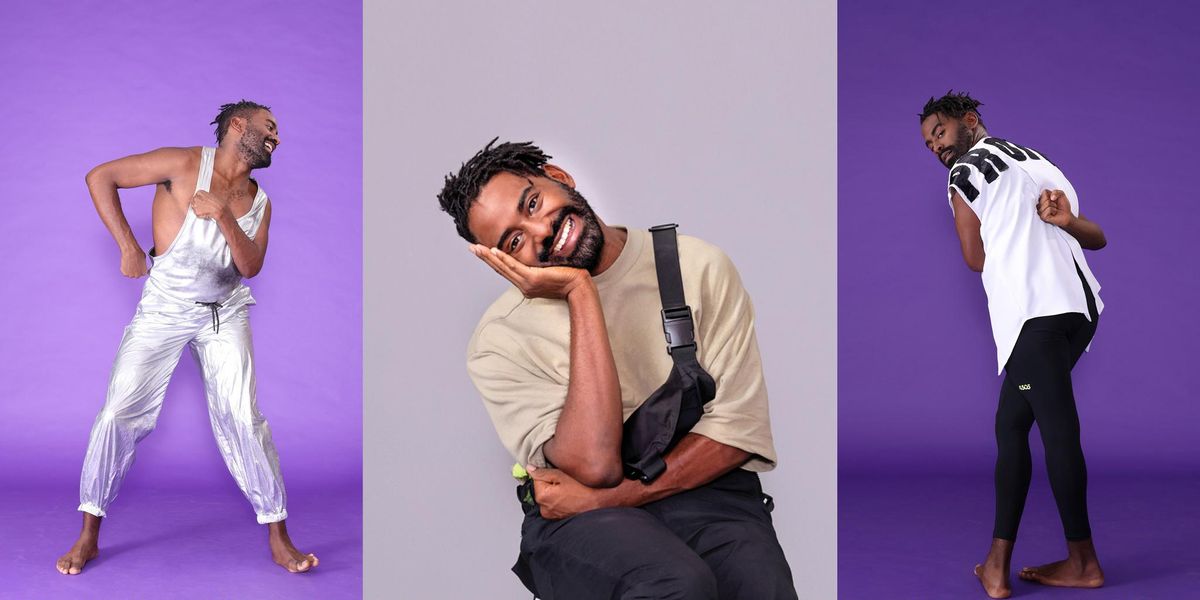Jerron Herman Invites Audiences to Witness Him and, In Turn, Witness Themselves
Jerron Herman wasn’t nervous. We were filming the video for “Who and Who,” by experimental musician XI.ME.NA. Even while he was improvising alone in front of the camera in a button-down shirt and tie—under blazing lights, on a slippery paper backdrop—he joked about feeling at home on set. I’d gone first (in heels), and I’d been nervous. But Jerron, my longtime colleague from Heidi Latsky Dance, mused that he was an exhibitionist at heart. We laughed.
Watching his takes, his easeful yet visceral groove popped out of the screen. Lit by an internal fire, whether on film, onstage or in life, he welcomes you to witness him and, in turn, witness yourself. His generosity of spirit is practically palpable.

Jerron Herman is a deep-listening, old-school romantic whose favorite words are “rigor,” “craft” and “community.” With recent choreographic commissions from the Whitney Museum of American Art, Danspace Project and Performance Space New York, he has generated a rich body of work that is deeply inspiring without being “inspirational.” While he creates primarily through the lenses of Blackness and disability, he creates for everyone. “There’s nothing in what I do that you cannot consume; you just choose what to eat,” he says. An interdisciplinary artist who works in dance, text and visual storytelling, Herman makes art because, he says, “my multiplicity wants to have a conversation with your multiplicity.”
Herman grew up in Alameda, California, in a home filled with Black art. The Hermans attended the theater, opera, cinema. His parents, Cynthia and Gerald, design clothing; his brother, Jacque, is an actor and arts educator. Herman laughingly describes himself as “the most brave but least creative” of the family.
Guided by the Christian principle that each uniquely made body is whole and purposeful, he cherishes cultural arti-facts of the Black church he grew up in—the fashion, the shouting, the abandon, the celebration of the corporeal and ecstatic. “Just like modern dance!” he quips.
His love of storytelling, or “how people talk about themselves or their desires,” as he puts it, was cemented by age 8, thanks to a teacher’s weekly writing prompt. Young Jerron was smitten by the process of making. Although there was no road map into a life consumed by art, he says, “There was no Plan B.”
He first moved to New York City in 2009 to attend New York University as an aspiring playwright. As an education apprentice with the New Victory Theater two years later, Herman assisted choreographer Seán Curran in a public school curriculum development workshop. After seeing him dance, Curran connected Herman with Heidi Latsky, whose company is physically integrated—by simply handing him a ringing phone that was calling Latsky’s number. Though Herman hadn’t trained formally as a dancer, at their first meeting, Latsky invited him to improvise. She loved the rhythms and isolations naturally present in his body and his “unencumbered” internality. “He wasn’t trying to be something else,” she remembers. As they started to work together, Herman allowed himself to push and be pushed, and he was a great team player. Their rigorous collaboration refined “when to rein it in, when to let it out,” she says, for a more powerful performance.
“Dance became my way to address performing outright, unfettered—something I’d never experienced,” Herman says. “I felt I deserved to try out this way of being, placing my creative and physical prowess in one context.”
After eight years in Latsky’s task-driven, intuitively guided process, Herman joined the research-based process of disability-led Kinetic Light, directed by Alice Sheppard. He’s currently collaborating on the development of the company’s WIRED. Operatic in scale, it tells the legacies of barbed-wire use in America, and the people who shape and have been shaped by it. Sheppard similarly values Herman’s unwavering devotion to rigor, process and care for others. “And then, when Jerron dances, he gives himself,” she says. “He drops in. And time seems to stop.”
To prepare his body for movement, Rubz ball in hand, Herman stretches to awaken his limbs, which can remain stuck due to his hemiplegia cerebral palsy, affecting voluntary movement on the left side of his body. He opens his hips to engage his left leg, allowing it to take weight for greater stability. Once he releases his back and hip, his weight drops into the floor. He’s ready.
Herman transforms his diagnosis into a celebratory generative force for movement research within and outside of traditional vocabularies. He distills what makes idiosyncrasies matter artfully. In explosive movement or stillness, “his face and body tell a story,” observes Jillian Hollis, Latsky’s rehearsal director. “Subtlety isn’t easy to perform.”
During .EDU & Me, a one-man play Herman wrote and performed in 2013, the character is supposed to put on a medical coat. Onstage, Herman put on the coat just partway, fearing the mechanics required to get the jacket all the way over his left arm were cumbersome and too time-consuming. After the show, a friend in the audience encouraged him to take the time necessary to put it on fully, telling him that audiences don’t get enough chances to see that. The comment seeded Herman’s confidence thereafter to harness the power inherent in the choice to reveal and to invite the gaze.

He furthered this investigation in Latsky’s human sculpture court ON DISPLAY, for which he wrote the textual score in 2015–16. In this piece, the audience has time to see the performers’ virtuosic stillness, ultimately destigmatizing difference. Herman’s own choreography now illuminates the rigor of minutiae, “taking what is mundane and exploding it,” he says. Composer JJJJJerome Ellis says, “Jerron’s practice in full embodiment is already a political act. He makes visible his disability, encouraging others to make theirs, and themselves, visible.”
Herman says he is inspired by the collaborative, interdisciplinary practices of Judson-era artists. Invested in what is coming out of what has already been, each of his pieces invokes the work of other disabled artists, whether through historical references or collaboration.
He also nurtures an authentic sense of welcoming by creating an aesthetic in which “many have a home,” he says. Though he may draw from specific experiences from the Black or disability communities, the finished product refuses to be pigeonholed. His work is replete with allusions, inviting moments of convergence amongst members of different groups. During a brief transition section in his Many Ways to Raise a Fist, from 2019, wearing a do-rag, Herman changes out of a tunic designed by his parents that’s embroidered with awareness ribbons on one side and the word “PROTEST” on the other; he’s lit in the color PMS 293C (aka “handicap blue”) and sitting on a text-emblazoned bench made by Shannon Finnegan, with resonant art pieces projected on the wall amid the aural backdrop of Philip Glass’ In the Upper Room. “I brought everyone to the table in that moment,” he grins. It hewed to the creative-writing principle of “Show, don’t tell,” which invites readers, or, in this case, audience members, into their own experience of a moment through attention to sensory detail. Even as a nondisabled white woman, I remember feeling lovingly enveloped in the work like a Robert Rauschenberg mixed-media collage that expands beyond its frame. With its elastic notions of time and memory through the juxtaposition of concrete and dreamlike elements, I was invigorated, swept up in the friction. And the joy.
In addition to his work as an artist, Herman is a dedicated advocate. “Jerron has a well-rounded perspective of the field, what it needs and his voice in it,” says Gregory Youdan, research and advocacy coordinator at Dance/NYC. Herman puts that perspective to use by serving on advisory committees for numerous organizations and as a trustee for Dance/USA. He’s also a teacher-choreographer for children with disabilities for the DREAM Project at National Dance Institute. Last year, he was named a 2020 Disability Futures Fellow, a joint initiative of the Andrew W. Mellon and Ford foundations. “I am beyond grateful to be thought of as the future,” he says.
His aesthetics also contend with the tension inherent in the question of “How can we give ourselves permission to be commended, have notice of our work, and not lose understanding of the fact that it’s not about us as individuals?” notes artist Ezra Benus, a member of Art Beyond Sight’s 2018–19 Art & Disability Residency cohort alongside Herman. To endeavor for the elevation of the collective is radical, given the self-serving demands of a dance career. Both during and since our overlapping tenures at Heidi Latsky Dance, Jerron and I have often had conversations about how the industry is evolving, how culture at large is shifting. He has been smack in the middle of that sea change. The goal of his work, onstage and in life, is for people to think differently about disability, or race, or other marginalized groups, not the rigor and craft necessary for great art.
In 2019, he was interviewed on behalf of Latsky’s Unfinished. The last question posed was, “In one word, what is dance to you?”
His choice? “Freedom.”

Bonus: The Dream Dinner Party
Conventional approaches to both writing and dance often privilege sight. Given Jerron Herman’s steadfast commitment to accessibility onstage and off, I asked him to envision his ideal multisensory dinner party.
Location:
“A suite at the Waldorf, overlooking the city, with candles on the tables, twinkling lights and the scent of fresh linen. Is that a hint of cinnamon?”
Guests:
“Past: Geoffrey Holder, Eartha Kitt, Tennessee Williams, my Granddad Stanley. Present: My brother Jacque, Deana Haggag, Ayishat Akanbi, you, me.”
Menu:
“Escargot. Spinach salad with goat cheese, walnuts, grapes. Duck. Affogatos for dessert. Malbec and champagne. A cucumber spritz as a palate cleanser.”
Soundtrack:
“Each guest picks two favorites for a playlist with Ella Fitzgerald standards.”
Apparel: “Pajamas? No, a tweed suit. Maybe a turtleneck. Colorful sneakers. Guests are invited to wear their favorite colors and comfortable shoes.”





